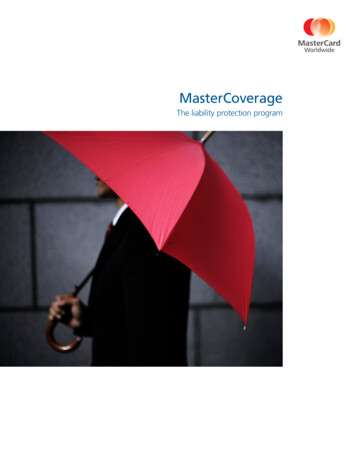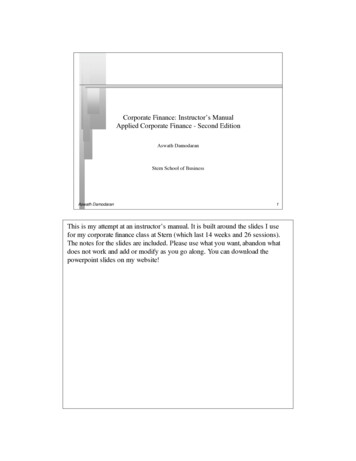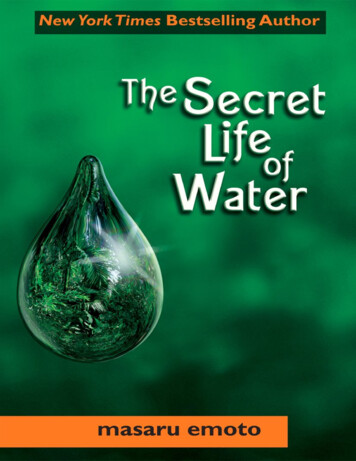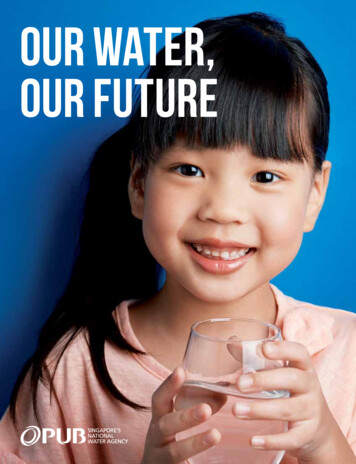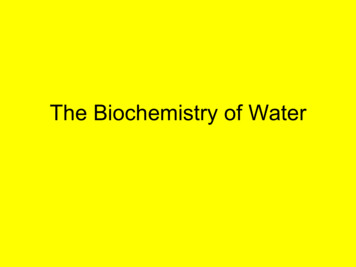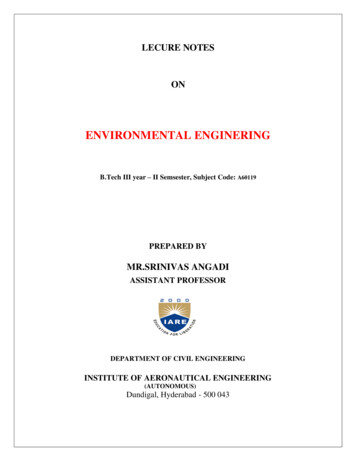
Transcription
Practical Application in Corporate Water StewardshipSeptember 2010Presented by:
Water LifeBut did you know Water covers about 70% of the Earth’s surface. Most of this water is undrinkable because 97% is salt water. Only 1% of water is found in rivers and streams. Approximately 1 billion people do not have access to safe drinking water. About 6,000 children die every day from diseases associated with lack of access tosafe drinking water. ost of the cities where large numbers of people live without taps and toiletsMhave plentiful water supplies. F reshwater fish and other aquatic animals are considerably more imperiled thanthose that live on land or in the oceans. I t takes 1,000 times more water to grow food for an individual than to meet thatperson’s needs for drinking. Irrigation increases yields for most crops by 100 to 400%. About 70% of freshwater withdrawals are used for irrigation. ater withdrawals for agriculture, assuming no gains in efficiency of use, areWexpected to increase by 45% by 2030. The Earth’s water is finite, but it is infinitely renewable.
ACKNOWLEDGEMENTSThis report is the result of collaboration between The Nature Conservancy and The Coca-Cola Company.It also represents the product of significant contributions of individuals from a number of other organizations: T he Water Footprint Network provided support for pilot study efforts and guidance throughpublication of the Water Footprint Manual. oca-Cola Enterprises Inc. (CCE) was a key partner for the Coca-Cola water footprint pilotCstudy, providing significant data and other resources. R esearchers at the Twente Water Centre, University of Twente, The Netherlandsconducted the technical work for the Coca-Cola water footprint pilot study. Denkstatt, in cooperation with the Institute for Water Quality, Resources and WasteManagement at the Vienna University of Technology, conducted the beet sugar waterfootprint pilot study. LimnoTech conducted the orange juice water footprint pilot studies and contributed technicalexpertise and writing support for this report.
— Benjamin Franklin
TA B L E O F C O N T E N T SExecutive Summary1.0 INTRODUCTIONES-111.1 Objectives of this Report21.2 Global Freshwater Challenges31.3 The Nature Conservancy’s Freshwater Conservation Goals51.4 The Coca-Cola Company’s Water Stewardship Goals61.5 The Water Footprint Concept82.0 PILOT STUDIES112.1 Water Footprint of 0.5 Liter Coca-Cola in PET Bottle112.2 Water Footprint of Beet Sugar Supplied tothe Coca-Cola System’s European Bottling Plants152.3 Water Footprint of Orange Juice Products203.0 PERSPECTIVES253.1 Setting Goals and Scope253.2 Water Footprint Accounting273.3 Water Footprint Sustainability Assessment303.4 Water Footprint Response Formulation324.0 LOOKING FORWARD374.1 The Coca-Cola Company’s Water Stewardshipand Sustainable Agriculture Strategy374.2 The Nature Conservancy’s Water Stewardship37
EXECUTIVE SUMMARYWhen properly managed, even large volumes of water use can be sustainable in locations wherethe resource is sufficient to support the use. The impacts of a water use need to be assessed in thecontext of all water uses in the watershed in order to define cumulative impacts, shared risks andappropriate response strategies.Traditionally, calculations of how much water a business uses have been based on the quantitiesused directly in producing that company’s products. In recent years, businesses have beenencouraged to look at their water use more comprehensively and investigate the water usedthroughout their supply chains. Together with The Nature Conservancy (“the Conservancy”),The Coca-Cola Company (“the Company”) has been one of the companies leading the way ondeveloping a “water footprint assessment” methodology through active participation in the WaterFootprint Network.A product water footprint is the total volume of freshwater consumed, directly and indirectly,to produce a product. A full water footprint assessment considers the impacts of this waterconsumption, as well as appropriate response strategies to minimize those impacts.Water footprinting and carbon footprinting are very different assessments. With carbon footprints,one can compare similar products (if the same boundaries and methodology are used) knowingthat lower carbon (or zero carbon) is better. On the other hand, water footprints help identify wherewater is used in the production of a product and what type of water is used. Water is local and thuswater footprint numbers must be considered in the context of the local watershed. The numberassociated with a water footprint is not the end game, but rather a starting point to addressing thesustainability of the water source.This report, prepared by The Nature Conservancy and The Coca-Cola Company, examines the conceptof product water footprinting and its practical application for addressing the growing challengesrelated to freshwater. Three water footprint assessments were conducted for the Company: C oca-Cola 1 in a 0.5 liter PET bottle produced by Coca-Cola Enterprises Inc. (CCE)in the Netherlands;Beet sugar supplied to Coca-Cola bottling plants in Europe; and Minute Maid orange juice and Simply Orange produced for the North American market.Water footprint assessments can be helpful in supporting corporate water stewardship effortsby providing a tool to measure and understand water use throughout the supply chain. They canCoca-Cola refers to the product brand.1ES-1
provide valuable insight into the largest components and locationsof water consumption, the potential effects on local watersheds, andfuture water availability to serve the collective needs of communities,nature, producers, suppliers and companies. In this way, water footprintassessments can contribute to an increased understanding of a business’water-related risks and vulnerabilities.General observations and implications for product water footprinting follow: The value of product water footprinting is its ability to disaggregate wateru se by component (i.e., direct and indirect use; green, blue and grey). It is important tokeep the components of a water footprint separate so that impacts can be assessedin the context of the local watersheds where the water is being sourced. T he largest portion of the product water footprints assessed as part of these pilotstudies come from the field, not the factory. The Coca-Cola Company sees significantopportunity to engage more directly with its agricultural suppliers in advancingsustainable water use. Guided in part by these assessments, the Company is focusingits initial efforts on sustainable sourcing of sugar cane and oranges. hile the operational water footprint associated with production was found toWbe a very small percentage of the total water footprint, it remains important forbusinesses to manage their direct/operational impacts on local water resources. Thisis especially true with regard to wastewater treatment. T o really gain an understanding of whether water use is having an impact, the volumeof water consumption must be considered with the cumulative effect of all uses ofthe shared water resource. hile water footprints are an excellent tool for companies to begin to understandWtheir water use, care must be taken when communicating about water footprintassessments. Numeric water footprints on labels do not provide information neededto make informed choices among products.Water footprinting is helping The Coca-Cola Company refine its approach to global waterstewardship. The pilot studies have verified the importance of examining direct and indirect wateruse separately. The Company is focusing first on operational water use by taking action to usewater more efficiently and treat all manufacturing wastewater. The studies also affirmed theCompany’s efforts to understand the health of watersheds everywhere it operates. Importantly,water footprinting provides compelling support for the need to engage more directly with suppliers,governments and other stakeholders on responsible water stewardship.ES-2
— Emperor Yu of China, 1600 B.C.
1.0 INTRODUCTION“People use lots of water for drinking, cooking and washing, but even more forproducing things such as food, paper, cotton clothes, etc. The water footprint isan indicator of water use that looks at both direct and indirect water use of aconsumer or producer. The water footprint of an individual, community or businessis defined as the total volume of freshwater that is used to produce the goods andservices consumed by the individual or community or produced by the business.”Water Footprint Manual: State of the Art 2009 2Water footprinting is a young science, and the methods for calculating water footprints are evolving throughthe efforts of the Water Footprint Network (WFN)3 and various other initiatives. The Nature Conservancyand The Coca-Cola Company are actively engaged in efforts to test the practical application of the waterfootprint methodology and explore opportunities for improvement. Both organizations have engaged inseparate initiatives related to water stewardship and water footprinting and have collaborated on projectsof mutual interest.Over the past two years, the Coca-Cola system4 has undertaken three water footprint pilot studies to assessthe practical application of the methods to its products. Together with The Nature Conservancy and theconsulting firm LimnoTech, the Coca-Cola system also has been exploring and quantifying the benefits ofwatershed restoration actions to restore and sustain adequate water supplies for the full range of beneficialuses.5 Because water-related impacts are local in nature, efforts to reduce or eliminate adverse impacts arebest implemented in the watersheds in which the impacts are occurring.The Nature Conservancy is drawn to this collaboration because it is committed to helping build solutions tothe world’s water problems so there will always be enough for people and nature. Helping corporations findbetter and more responsible ways of using water is an essential step on the pathway to water sustainability.Two simple facts drive The Nature Conservancy’s interest: T remendous opportunities exist to improve the way water is used and managed, and therebyalleviate water scarcity problems that affect both people and nature. Fostering such improvementsis a high priority for the Conservancy, because unsustainable water use is a leading cause ofdeclines in freshwater biodiversity. C orporations can provide leadership in implementing sustainable water practices. These improvedwater practices make good sense for businesses and can bring substantial benefits to freshwaterecosystems.The Company is drawn to this collaboration because it recognizes that engaging external partners isessential to its commitment to have a positive impact on the water challenges facing communities andnature. The Conservancy brings focused expertise in freshwater conservation science and an in-depthunderstanding of the interrelationships between healthy ecosystems and the communities they sustain.Through the collaboration, both organizations are able to leverage their strengths to address waterchallenges locally, at a global scale.Hoekstra, Arjen Y., A. Chapagain, M. Aldaya, and M. Mekonnen. 2009. Water Footprint Manual; State of the Art 2009. Published by the Water Footprint Network.www.waterfootprint.org4The “Coca-Cola system” refers to both The Coca-Cola Company (also referred to as “the Company” in this report) and its more than 300 bottling partners.5LimnoTech and The Nature Conservancy. 2010. Quantifying Watershed Restoration Benefits in Community Water Partnership Projects.231
Maps such as this one showthe degree of stress fordifferent regions based on theratio of water use to wateravailability (water replenishednaturally by precipitationand snow melt). Water stressindices are calculated indifferent ways, as discussedlater in this report.Degree of Water Stressby Freshwater EcoregionExtreme stressHigh stressModerate stressLow or no stressMinimal water useUnassessed1.1 OBJECTIVES OF THIS REPORTThis report was prepared for water resource managers, water footprint practitioners, partners of the WaterFootprint Network and others interested in how water footprinting can help inform a company’s waterstewardship program. The purpose is to share lessons learned and observations related to water footprintassessments and their practical application. The Nature Conservancy and The Coca-Cola Company hope thatthe information shared in this document will make a positive contribution to the ongoing development of thewater footprint assessment methodology and its application.2
Map from The Atlas of Global Conservation (University of California Press, 2010).For more information, please go to: The Nature Conservancy, www.nature.org/atlas.1.2 GLOBAL FRESHWATER CHALLENGESWater is the core of our being. Two-thirds of the human body is made up of water, and we must continuallyreplenish it. Analogous to losing oil in an automobile, being down only a few quarts of water can be fatal.But it takes a lot more than drinking water to keep us healthy. We need water for cooking and bathing. Weneed water to grow food and generate electricity, to produce the clothes on our backs and the countlessother goods we use in our daily lives.There would be enough water to support all of humanity, now and for decades to come, if it were evenlydistributed around the globe and delivered from the skies at a constant rate. At a global scale, we consumeless than 10% of all the water that replenishes rivers, lakes and aquifers each year.3
But all too often, rain comes as a deluge or not at all, making its capture and storage elusive. It also isnot distributed evenly. The Atacama Desert in northern Chile may go for more than 20 years without rain,whereas Mt. Waialeale on Kauai in the Hawaiian Islands averages more than 12 meters of rain a year.Perhaps most importantly, the growth of our global population has not followed the rain.These facts of life explain the patchiness of water scarcity and abundance. Today, nearly 1 billion peoplelack access to clean water. If current water consumption patterns continue, two-thirds of the world’spopulation will live in water-stressed conditions by 2025.The highly variable tapestry of water scarcity and the conflicts, impacts and risks that derive from it mustultimately be addressed in local watersheds. Governance policies at various geopolitical levels can certainlyinfluence how water is used, but the great spatial variability in water availability and use, along withother influences on hydrologic systems, including local land use, demand that any assessment of potentialimpacts, risks and sustainability of water use be framed by the physical bounds of the watershed.This explains the recent trend within the Water Footprint Network toward a focus on evaluating theconsequences of water footprints in local watersheds. Ongoing calculations of the water footprints ofindividual products or whole nations have increased awareness that water is consumed throughout thesupply chain in the production of all consumer goods. This information will continue to serve an importantrole in informing public policy around water use and management. Within the corporate world, waterfootprints enable a greater understanding of the volume of water embedded in products, the potentialeffects on local watersheds caused by the water use and the probabilities of future water availabilityto serve the collective needs of the company, communities and nature. Not understanding the collectiveimpacts of water use on the local watersheds can increase risks to the business. As discussed later inthis report, both the Conservancy and the Company have embraced and continue to support this importantevolution in water footprinting.From a corporate perspective, growing water scarcity and the need to use water in business operations andsupply chains pose risks of various types. These business risks can be viewed from two perspectives: onelooks at “upstream” risks, and the other focuses on “downstream” risks.4
Upstream business risks are generally centered on the question of whether or not a company can expectto have sufficient supplies of clean water in the future to support its business. This area of risk can beinfluenced by increasing competition for water resources, growing water scarcity, drought, climate change,water source contamination, infrastructure failure, poorly managed water allocation systems, ineffectivepublic sector management capacity, insufficient water resource management policy and other factors.Downstream business risks stem from the fact that a company’s water use and wastewater treatmentpractices may impact other water users and stakeholders.Water-related risks must be addressed within the context of the local watersheds. It is important toconsider the impact of a company’s water use in conjunction with the impacts from all water users in thewatershed, as impacts are cumulative. The risk of water scarcity and/or poor quality is not only a businessrisk, but a risk shared with the community and other users. Efficiency improvements are important, but themost appropriate response actions may not always involve reduction of the water footprint (sometimes areduction of a water footprint is not possible). In many cases, policy and regulatory engagement to supportimproved management of the shared resource may be a more appropriate response.When water resources are adversely affected by the cumulative impacts from multiple uses, whether thoseimpacts are a result of a company’s use, real or perceived, it can affect that company’s social license tooperate. It also may trigger regulatory responses from governments. These social and political reactions canlead to increased water acquisition and treatment costs, reduced water supply, more stringent wastewatertreatment requirements, riskier infrastructure planning and capital investments and potential reputationdamage. In rare cases, the business may be shut down by the local government or may otherwise no longerbe viable and voluntarily shut down.The Conservancy and the Company have been collaborating on an exploration of various approaches andtools for assessing and managing water-related risk. We are learning as we go. This report summarizessome of our early findings.1.3 THE NATURE CONSERVANCY’S FRESHWATER CONSERVATION GOALSThe Nature Conservancy is an international non-governmental organization dedicated to the conservation ofbiological diversity. The Conservancy’s mission is to preserve the plants, animals and natural communitiesthat represent the diversity of life on Earth by protecting the lands and waters they need to survive. TheConservancy’s on-the-ground conservation work is carried out in all 50 states in the U.S. and in more than 30other countries, and it is supported by approximately one million individual members. The Nature Conservancyhas protected more than 47 million hectares of land and hundreds of rivers and lakes around the world.While the Conservancy’s mission is focused on sustaining the Earth’s diversity of plants and animals,the organization’s broader contribution to society is in the protection of the life support systems of ourplanet – we cannot protect the diversity of life on this planet, including human life, without protectingthe ecosystems that sustain us all. Natural ecosystems provide humanity with clean water, food and fiber.Natural resources derived from ecosystems support major sectors of our economy, whether in the form offisheries that sustain coastal communities or through tourism economies that rely so heavily upon naturebased recreation. Healthy natural ecosystems perform an array of valuable services with substantialeconomic values, including purifying our water supplies, sequestering carbon and helping to regulate theclimate and hydrologic cycles of our planet.5
Through its work on more than 600 freshwater projects around the world, the Conservancy has learnedwhat it takes to make rivers and lakes healthy and keep them healthy. The organization has deep roots incommunities around the world, bringing resources, expertise and tools that empower people to protectwaters that sustain families, livelihoods and ways of life. Especially for the world’s poor, partnering withthem to preserve their natural sources of water, food and other necessities helps preserve their cultures,their economic potential and their power of self-determination. Some of these freshwater projects focuson iconic waters that are the lifeblood of nations, like the Great Lakes and Yangtze River. Some are lesserknown, yet are hubs of innovation, like the Penobscot River in Maine, which is a proving ground for solutionsthat can accelerate and improve protection of rivers and lakes around the world.The Conservancy understands that to reach its goals, the organization must also equip people with betterways to use the water resources nature gives us. Doing so benefits not only the Conservancy’s freshwaterprojects, it also creates a ripple-effect that benefits countless other rivers and lakes around the world.Therefore, a key aspect of the Conservancy’s work is giving leaders in government and business pragmaticalternatives to wasteful and destructive ways of using rivers and lakes. The Conservancy’s commitment tothe advancement of water footprinting supports these objectives.Through its work in watersheds around the world and collaborations with governments, corporations andlocal communities, the Conservancy expects that by 2015, it will bring enhanced protection and restorationto more than 1.5 million kilometers of river and improved water, food and electricity security to more than200 million people.1.4 THE COCA-COLA COMPANY’S WATER STEWARDSHIP GOALSWater is a key ingredient in all of the Company’s products. It is essential to the Company’s operationsand the well-being of the communities and ecosystems where the Company operates. In response to thevery real and growing vulnerability of the freshwater that sustains the business, the Company’s aim is toestablish a truly water-sustainable business on a global scale through a commitment to water stewardship.The Company’s water stewardship journey began with a focus on water use in its own operations, whereit has greater influence. In 2005, the Company conducted global water risk assessments to gain a betterunderstanding of the potential water risks facing the business, local communities and ecosystems. This ledto the establishment of the Company’s water stewardship framework, which focuses on plant performance,watershed protection, sustainable communities and raising global awareness and action around waterchallenges (Figure 1).Risk assessments were updated in 2008, and a system-wide requirement went into effect that allCoca-Cola system bottling plants evaluate the sustainability of the water resources used to produce theirbeverages, as well as the sustainability of the water resources used by the surrounding community. Theseevaluations include detailed assessments of the vulnerabilities associated with quantity and quality of localwater resources, and they result in the development of source water protection plans in partnership withcivil society and governments. All plants are required to complete this process and be actively implementingtheir protection plans by 2013. These source water protection plans address critical water challenges at awatershed level, from hydrological vulnerabilities to local government management capacity.6
UNITIESGLOBALAWARENESSAND ACTIONFigure 1. The Coca-Cola Company’s Water Stewardship FrameworkIn addition, the Company set an aspirational goal in 2007 to safely return to communities and nature anamount of water equivalent to what is used in all of its beverages and their production. The formulationof this target came from dialogue with the international water stakeholder community and set metrics forwater stewardship.The Company has set targets to guide its water stewardship in three areas: Reduce the Company’s water use ratio while growing the unit case volume, with a target toimprove water efficiency by 20% over 2004 levels by 2012. By 2009, the Company had achieved a12.6% improvement over the 2004 baseline.6 Recycle the water used in operations by returning treated process water to the environment ata level that supports aquatic life by the end of 2010. In 2009, 89% of Coca-Cola system facilities(approximately 95% of reported volume) were in compliance with the Company’s wastewatertreatment standards.6 Replenish the water used in finished beverages by participating in locally relevant projectsthat support communities and nature, and meet and maintain this goal by 2020. Estimates are thatby the end of 2009, the Company was replenishing approximately 22% of the water used in itsfinished beverages through the support of some 250 community water programs in approximately70 countries.6,7,8,9The Company, recognizing that water use in agriculture is a significant component of the water footprint,has established a sustainable agriculture program. The strategy extends beyond water resources andconsiders environmental impacts, social implications and economic pressures. The Company’s approach tosustainable agriculture is multi-dimensional and founded on principles to uphold workplace rights, protectthe environment and help build sustainable communities.Supporting documents can be found on The Coca-Cola Company’s website: www.thecoca-colacompany.com/citizenship/community initiatives.html.The Coca-Cola Company. 2010. Replenish Report.8LimnoTech and The Nature Conservancy. 2010. Quantifying Watershed Restoration Benefits in Community Water Partnership Projects.9Global Environment & Technology Foundation with Dr. Albert Wright. 2009. Quantifying Water Access Benefits in Community Water Partnership Projects.677
Water footprint assessments can be helpful in supporting these water stewardship efforts by providing atool for understanding and measuring water use throughout the Coca-Cola system’s direct operations and itssupply chain. The Company has been actively involved in the exploration of the concept of water footprintingfor several years, and it was instrumental in forming the Water Footprint Working Group (WFWG) thatcommissioned several early studies addressing water footprints and water offsets. The WFWG evolved intothe Water Footprint Network (WFN) in 2008, and the Company continues to be an active member of and anintegral contributor to the development process.The Company also is engaged in activities of the Beverage Industry Environmental Roundtable (BIER),a coalition of global beverage companies working together to drive continuous improvement in waterconservation and resource protection. The Company is a member of a working group of BIER that isdeveloping sector-specific guidelines for calculating the water footprint of a beverage product or enterprise.In addition, The Coca-Cola Company became one of the first companies to commit to the United NationsGlobal Compact’s CEO Water Mandate. This program is designed to help companies better manage wateruse in their direct operations and throughout their supply chains. The Company is an active participant inthree work streams on: Responsible Business Engagement with Water Policy and Management, Water andHuman Rights, and Corporate Water Disclosure.1.5 THE WATER FOOTPRINT CONCEPTWater footprinting builds on the concept of “virtual water,” which refers to the water “embedded” in aproduct; that is, water that is consumed in direct operations and throughout the supply chain. A waterfootprint of a product considers both direct (operational) and indirect (supply chain) water use. It also refersto where and when the water was used. A water footprint has three components: T he green water footprint refers to consumption of green water resources (rainwater storedin the soil as moisture); T he blue water footprint refers to consumption of blue water resources (surface andground water); T he grey water footprint refers to pollution and is defined as the volume of freshwater that isrequired to assimilate the load of pollutants based on existing ambient water quality standards.The term “consumption” with respect to green water refers to rainwater lost to the atmosphere from theland surface when it is taken up and transpired by plants (“evapotranspiration”), plus rainwater incorporatedinto the harvested crop. The term “consumption” with respect to blue water refers to surface wateror groundwater that is evapotranspired, incorporated into a product, returned to a different watershedor returned during a different time period. Together, the green and blue water footprints make up the“consumptive” water footprint. This water is not available downstream for other uses.Grey water results from green or blue water that is not consumed. For instance, when rain (green water)falls on agricultural land and then runs off the field, it may carry eroded soil or chemicals, such as fertilizers,into an adjacent water body, thereby creating grey water. When blue water is withdrawn from a river, lake oraquifer and used in manufacturing processes, it may be returned to a water body as grey water, containingmore or less pollutants than the water that was originally withdrawn. The calculation of a grey water8
footprint is based on the quantity of water necessary to dilute or assimilate pollutants in the grey water tosuch a degree that the water becomes suitable as blue water for other downstream uses. Green, blue andgrey water footprints are all represented as water volumes.Figure 2 depicts the components of a water footprint. For a product, the direct water footprint refers towater consumed in operations. Indirect water use r
2.3 Water Footprint of Orange Juice Products 20 3.0 PERSPECTIVES 25 3.1 Setting Goals and Scope 25 3.2 Water Footprint Accounting 27 3.3 Water Footprint Sustainability Assessment 30 3.4 Water Footprint Response Formulation 32 4.0 LOOKING FORWARD 37 4.1 The Coca-Cola Company's Water Stewardship and Sustainable Agriculture Strategy 37


